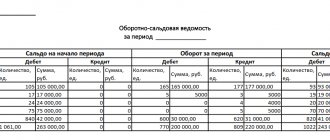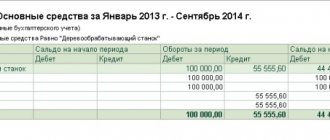The authorized capital has been formed and declared - what posting is necessary?
Commercial legal entities (PJSC, JSC, LLC, business partnerships, state unitary enterprises, municipal unitary enterprises) are created with the mandatory formation of an authorized capital (MC).
The size of the management company, the share of participation in it of each of the founders, payment terms, form of contributions and assessment of non-monetary contributions are stipulated in the constituent agreement. The authorized capital is the starting amount of funds with which a legal entity begins its activities. After completion of all activities for making contributions to the authorized capital, postings begin with the corresponding entry made on the date of its registration. It should reflect the accrual of the full amount of the capital provided for by the charter, in correspondence with the debt of the founders on contributions to it: Dt 75 - Kt 80.
Analytics on account 80 (accounting capital account) is organized according to:
- founders (participants);
- stages of formation (in PJSC, JSC and business partnerships);
- types of shares (in PJSC and JSC).
Account 75 is the account for settlements with the founders. The debit balance of its subaccount, reserved for settlements of contributions to the capital account, will show the amount of the unpaid capital account.
For information on how the capital account will be reflected in accounting, read the article “Procedure for drawing up a balance sheet (example)” .
ConsultantPlus experts explained in detail how the authorized capital is paid. If you have an LLC, this Ready Solution will help you. If AO, this material is for you. If you do not have access to the K+ legal reference system, get a trial demo access for a while. It's free.
Contribution to the authorized capital - postings
3. The total value of net assets at the end of the year must be greater than the amount of founding funds specified in the documents. This condition is considered very important because if it is not met, the company must declare a reduction in the size of its assets. And in accordance with the law, such a company is subject to liquidation.
1. Payment of active funds, the amount of which was determined at the time of creation of the company. The stated amount must be paid in full. In the law, this clause applies even to those enterprises that have carried out state registration in the current year.
- Leverage from non-board lenders. The creditor has the right to demand membership in the board of founders to guarantee the return of their money. The bylaws could be amended to allow him to resign from the board with priority for a full refund of his funds.
- Contribution by a new member of the community to the authorized capital. The company may decide to increase capital by attracting new people after one of the founders transfers its share to another person.
- The organization has the right to expand its authorized capital at the expense of property. An amendment for such an expansion is possible solely on the basis of the financial statements for the previous year.
- Expansion by executive authorities.
In most countries, the level of authorized capital is one of the important criteria determining the possibility of cooperation with this organization. In Russia, the lower value of possible capital is ten thousand rubles, which makes it not a suitable criterion for analyzing the state of a company in most situations.
Contribution to the capital of another organization from its founder
A commercial legal entity can be created by both individuals and organizations. At the same time, foreigners may be present among both.
By participating in the creation of a legal entity, the founder assumes obligations to pay for the contribution to its management company, in return acquiring the right to part or all (depending on the share of participation) of the property of this legal entity and to receive income from participation in its activities. There is a peculiarity here: when posting, the authorized capital must be reflected both for the founder and for the company receiving the contribution.
On the date of registration of the newly created organization, the founder - a legal entity registered in the Russian Federation, in its accounting shows the debt for the amount of the contribution to the capital specified in the founding agreement, which for it is a financial investment: Dt 58 - Kt 76. Credit balance on the subaccount of account 76, allocated for calculations of contributions to the management company, will show the amount of the management company unpaid by the founder.
The legislation allows payments to the management company both in money and in property or property rights. On the date of making the contribution (the full amount or part thereof), both the founder and the legal entity established by him are repaid the corresponding part of the existing debt.
Assets in modern enterprises
The assets of an enterprise are the totality of its tangible, intangible, finances
According to the nature of their use in the activities of the enterprise, assets are divided into two types:
- Fixed assets . They include fixed assets (means of production), equipment, construction in progress, intangible assets, and financial long-term investments.
Fixed assets are the property of an enterprise that is involved in the production process, but is not consumed. They are designed to influence objects of labor in the process of transforming them into finished products. LLC funds are determined to be in this category according to accounting rules.
They are accounted for at their original cost.
To reflect transactions with them, accounts are used: account. 01, which summarizes all information about the state of fixed assets, account. 20, sch 03, sch. 02; sch. 04, count. 08, sch. 05, sch. 07, count. 23, sch 87.
- Current assets . These are objects of labor that consume themselves during one production cycle. They include materials, work in progress, short-term investments, production, cash, etc.
For working capital, the following accounts are used: account. 57, count. 97, count. 50, count. 41, count. 19, count. 10, count. 71, count. 43, count. 51, count. 52, count. 55, count. 62, count. 58, etc.
All assets of a business are shown on the left side of the balance sheet.
The sources of their enterprise are recorded on the right side in the “liability” column.
Sources can be own or borrowed. One of its own sources is the authorized capital of the enterprise (or authorized capital).
Authorized capital is a set of funds, monetary and property, which is contributed by the owners of the enterprise upon its registration. It is registered in government organizations and in the charter of the enterprise.
The authorized capital is used to determine the financial condition of the enterprise. To calculate such indicators - financial stability, profitability, business activity. It is the starting capital of the enterprise and a guarantee for creditors.
When registering an enterprise, all participants must contribute at least 75% of the share; they can pay the rest over the next year.
The minimum amount of capital depends on the minimum wage, which changes every year.
Authorized capital – depositing funds into the current account and cash register
The easiest way to make a deposit is to pay it in money: to a current account or to a cash desk. For foreign participants, payment to a foreign currency account is acceptable.
Postings for contributions to the authorized capital in cash will be as follows:
- at the payee: Dt 50 (51, 52) – Kt 75;
- for the Russian founder: Dt 76 – Kt 50 (51).
Find out how to determine the amount of authorized capital in ConsultantPlus. To do everything correctly, get trial access to the system and go to the Ready solution. It's free.
Authorized capital and procedure for its payment
Authorized capital means funds that were initially invested by the founders or shareholders to ensure authorized activities. The size of the authorized capital corresponds to the property minimum, which guarantees the interests of the creditors of this legal entity.
The form of the authorized capital is regulated by law and directly by the organization’s charter. The size of the authorized capital may include the following components:
- par value of shares issued by the organization;
- government investments;
- private shares;
- buildings, structures, equipment;
- the right to use the results of intellectual property.
In order for an organization to be registered, it is necessary to contribute at least 50% of the authorized capital. But it should be noted that the legislation provides an exception for such an organizational and legal form as a joint-stock company. A joint stock company can obtain state registration without contributing authorized capital. But at the same time, half or more of the amount of the authorized capital must be paid for a period of no more than 3 months after state registration, the rest - no later than a year.
Contribution of property
Any type of property and rights to it can be transferred to the deposit: fixed assets, intangible assets, inventories, securities, debt on borrowed funds. The parties transfer the property contributed to the management company at the value agreed upon by them in the constituent agreement. At this value, the contribution is taken into account in accounting. For a contribution to the authorized capital formed in this way, entries are made to the recipient at the cost reflected by the founder. The founder, when forming the amount of the contribution made to the management company, adjusts the actual value of the property to the value agreed upon at the expense of other income and expenses (account 91). Regardless of the cost, records of property received by a legal entity are kept as part of the same type to which it belonged to the founder.
If the transferred property was subject to VAT upon acquisition, and it was presented to the budget, then the founder shall restore the tax either in full or in proportion to its residual value (for depreciable property). Recovered VAT is included in the deposit amount and is indicated in the transfer documents. The transferring party pays it to the budget, and the receiving party can take it as deductions.
The contribution to the authorized capital formed by the property is accompanied by the following transactions:
- For the receiving party:
Dt 07 (08, 10, 11, 21, 41, 58, 66, 67) – Kt 75 - property received;
Dt 19 - Kt 75 - accepted for VAT accounting on it.
- From the founder:
Dt 02 (05) – Kt 01 (04) - the residual value of the disposed depreciable property is formed;
Dt 76 – Kt 01 (04, 10, 11, 21, 41, 58) - property transferred;
Dt 76 - Kt 68 - VAT on transferred property has been restored;
Dt 76 - Kt 91 (or Dt 91 - Kt 76) - the value of the transferred property has been brought to the agreed value.
If you have access to ConsultantPlus, check whether you have correctly reflected the contribution to the management company with property. If you don't have access, get a free trial of online legal access.
Contribution of property to the fund
According to existing laws, not only money, but also various property can be contributed to the authorized capital. The monetary value of the property contributed by the founders is approved by a decision of the meeting.
Replenishment by the founders of the fund from their own funds
Additional funds received from participants of the enterprise free of charge are the income of the organization. Information about their cost is contained in the invoice. 98-2 “Gratuitous receipts” and in the account. 99 “Income of the organization.”
When carrying out this operation, records are kept:
- receiving free funds to a bank account : D-t 51, K-t 98-2;
- recognition of funds as other income : D-t 98-2, K-t 91-1 “Other income”;
- tax asset: Dt 68 subaccount. “Calculations for income tax”, K-t 99 “Profits and losses”.
Contributions of fixed assets to the authorized capital
If the founders pay their contribution with fixed assets, then the accounting entry looks like: D-t account. 08 “Investments in non-current assets”, Set of accounts. 75.
Increase in capital: contribution in cash or property
The legislation allows for an increase in the capital capital by decision of its founders (participants) if the following conditions are met:
- the PJSC or JSC has registered an additional issue or conversion of shares in the SBRFR and the Federal Tax Service;
- not only the initial charter capital is fully paid, but also the part by which the increase occurs.
Sources of increase in capital can be:
- retained earnings of a legal entity or its additional capital - in this case, additional payments from the founders (participants) will not be required;
- funds of participants: one, if it is accepted additionally, single or several, if they increase the share of their participation, or all, if the increase in share occurs due to a proportional increase in existing shares or par value of shares.
The procedure for accounting for the accrual and payment of additional contributions to the capital company when it increases is absolutely the same as that used when creating a legal entity. The founders (participants) determine the amounts, form and terms of payment in their decision. Entries for the accrual of obligations are made on the date of the decision to increase the capital and on the date of registration of changes in the charter, and entries for payment - on the actual date of transfer of funds or transfer of property (property rights).
Read about the nuances of taxation of contributions to a management company in the material “ List of income not taken into account when establishing the size of the profit base in accordance with Art. 251 Tax Code of the Russian Federation " .
Conditions for participation in the tender competition
If it is necessary to increase or decrease the authorized capital, the following conditions must be met :
- it must be paid in full;
- the amount by which the authorized capital has increased should not be lower than a value equal to the net assets of the organization minus the total value of the authorized and reserve funds;
- net assets at the end of subsequent years must be greater than the authorized capital.






